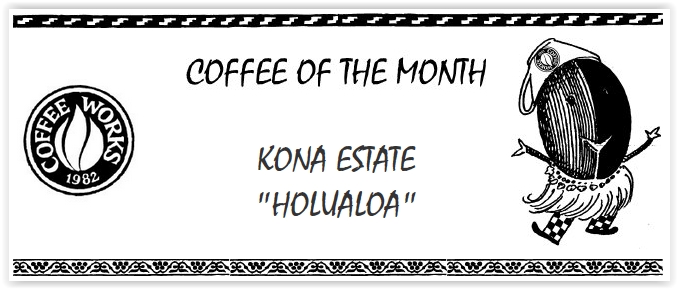Kona Estate “Holualoa”

In Fall 1982 Coffee Works fired up its fluidized-bed roaster and poured out the first batch of our fresh-roasted specialty coffee to what was then a decidedly-sleepier Sacramento. To celebrate the fifteenth anniversary of this company and civic awakening we are offering a special selection of (appropriately) original, authentic, and unique estate coffee from the big island of Hawaii.
Tropical islands and distinctive coffee go hand in glove: Hawaii, Jamaica, Sumatra. Java, Celebes, Timor, et cetera. These frost-free paradises all offer ideal growing conditions for the tender coffee plant: Mineral-rich volcanic soils, mild temperatures, frequent rain, abundant sunshine, and cooling ocean breezes. Just provide shade from the hot afternoon sun and you have the long, slow growing season needed for mild taste character to develop.
Holualoa (Ho-lu-a-lo-a) is situated at the apex of the Kona coffee lands on the western slopes of the volcano Hualalai. Shielded from the prevailing winds by the peaks Mauna Loa and Mauna Kea, the trees enjoy morning sunshine, an almost continual gentle rainfall, and a protective mist that rolls in from the sea like clockwork every afternoon. These greenhouse-like growing conditions have made Kona the most pampered coffee in the world. The traditional Kona coffee lands lie on a narrow, 12 mile long strip of land stretching from Holualoa in the North to Honaunau in the South, at altitudes of from 700′ to 2000′.
In the Hawaiian language Holualoa literally means “long sled run”, a reference to the zany ancient Hawaiian sport of riding wooden sleds (holua) down steep grassy slopes. Loa (long) meant the longest ride. This colorful history has meaning for us today, since neither the lush grass needed for land sledding nor coffee will thrive on the entirely lava rock stretches of the island; but rather only on the pockets of fertile, deep soil such as are present at Holualoa.
 Traditional mauka (highland) Kona coffee is rare. For example, the 1997 Holualoa Estate shipment consisted of 70 sacks (out of 200 total bags produced this year). Until the late 1970’s coffee production in Hawaii had been on a long, slow decline. The revival in interest (and prices) has created a demand that somehow will be filled. Planting of coffee trees on Hawaii, Molokai, and Kauai is booming. Some forecast Hawaii state will produce 6 million bags per year by the year 2000 (as much as Mexico exports today). Whether the revival in coffee growing in Hawaii has produced a better Kona coffee or simply more of it is still a matter of debate.
Traditional mauka (highland) Kona coffee is rare. For example, the 1997 Holualoa Estate shipment consisted of 70 sacks (out of 200 total bags produced this year). Until the late 1970’s coffee production in Hawaii had been on a long, slow decline. The revival in interest (and prices) has created a demand that somehow will be filled. Planting of coffee trees on Hawaii, Molokai, and Kauai is booming. Some forecast Hawaii state will produce 6 million bags per year by the year 2000 (as much as Mexico exports today). Whether the revival in coffee growing in Hawaii has produced a better Kona coffee or simply more of it is still a matter of debate.
CW illustration by Warren Dayton
Our supplier for this lot, a Kona specialist at Royal Coffee, describes Holualoa Estate as a “classic”: a “truly great Kona…intensely aromatic with chocolate and cinnamon in the nose, medium body with a lively sparkle on the palate, and a lingering mildly acidic finish.” In our cuppings we have been impressed with the intensity of Holualoa’s flavors, its elegant balance, and velvety smoothness. As with all our favorite coffees, the chocolate-y Kona richness persists and new flavors emerge as the liquor lingers on the tongue and the aromas saturate the palate.
“Fancy Kona coffee brings a high price, often selling on a par with fancy Costa Ricas.” So wrote William Ukers, the legendary coffee authority, in 1935, and inadvertently demonstrated that while coffee experts have been grousing about the price of Kona for decades, coffee drinkers continue to drive the price of Kona higher and higher. Our regular customers will recall that we have not roasted Kona coffee for many months, due to questions of both value and provenance. With Holualoa Estate however, such reservations and self-restraint evaporate, even though the price remains as mauka as the farms.
On the special occasion of Coffee Works’ 15th anniversary celebration therefore, you are invited in the name of coffee science to join us in imbibing the stuff of coffee legend.


